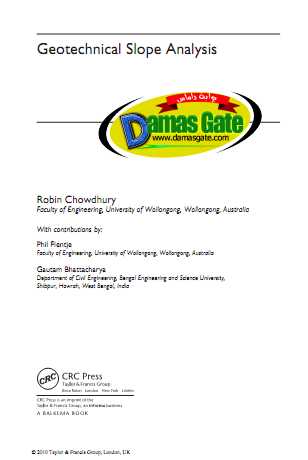Geotechnical Slope Analysis

1.1 INTRODUCTION
The construction, design, remediation and maintenance of slopes have always formed an important area of geotechnical engineering which is often termed as ‘slope engineering’. The wide variety of applications of slope engineering include excavations, hill roads, railway lines, embankments, earth dams, reservoirs, open-cut mines, urban development of hilly areas, protection of river banks and coastal slope stability. The study and analysis of slopes is essential for understanding their performance
and, in particular,
their stability,
reliability and deformations. Thus geotechnical engineers
often seek to calculate values of quantitative indicators of performance such
as the factor of safety (safety factor), lateral deformation, and probability of failure
and reliability index. Important concepts of geomechanics and, in particular,
of soil mechanics have been vitally important for developing the basic mechanistic models
of slopes and the associated methods of analysis, both simple and sophisticated.
However,
it is widely recognized that interdisciplinary approaches are required for
a complete understanding of slope performance and for the choice of realistic models
and methods of analysis for specific sites. Geoscientists have made significant contributions
to the understanding of natural slopes, their evolution and performance over
the long-term. To
that end, they are concerned with modeling natural and other processes
much more than considering specifics of stability analysis, slope design and remediation
which are understood to be the main concerns of geotechnical engineers. However,
the input of geoscientists is often valuable for slope engineering including the development,
choice and use of mechanistic models. In fact, a geotechnical engineer would
start detailed modeling after studying the geological report of a site and often after
considering the specific observations made by an engineering geologist.
Download
http://s18.alxa.net/s18/srvs2/01/Geo...e.Analysis.rar